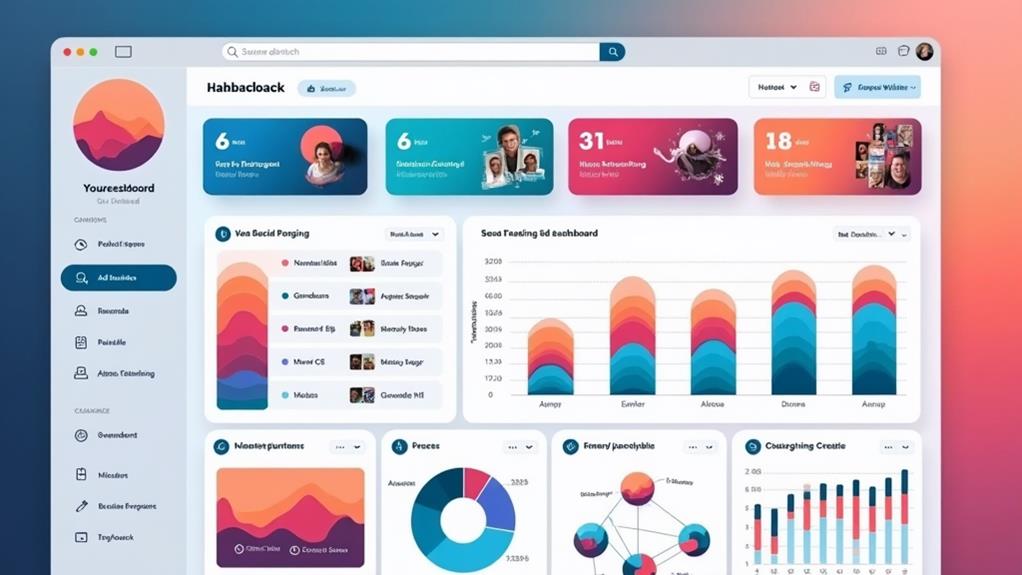
Leveraging Facebook Ads to boost your social media presence involves clear strategic steps. Begin by linking your Facebook business page to Meta Business Suite for streamlined ad management. Define your target audience using Facebook Audience Insights to analyze demographics and behaviors. Utilize varied ad formats like image, video, carousel, and slideshow ads to engage viewers. Craft compelling content with visual storytelling and interactive elements. Monitor key performance metrics such as CTR and CPC via Facebook Ads Manager and adjust your budget based on real-time performance. Implementing these data-driven strategies can greatly enhance your social media engagement. Discover more effective techniques for optimizing your ad campaigns.
Key Takeaways
- Utilize Facebook's Audience Insights to target demographics and interests effectively.
- Create engaging video ads to increase shares and interactions.
- Set a daily budget to ensure consistent ad display and cost control.
- Use custom and lookalike audiences for precise and expanded reach.
- Regularly monitor ad performance metrics to optimize strategies and improve engagement.
Understanding Facebook Ads
With the ability to connect with over 2.9 billion active users, Facebook Ads offer a powerful platform for businesses aiming to amplify their social media presence. Effectively leveraging this potential begins with understanding key components such as ad objectives, performance metrics, and audience segmentation.
It's essential to identify audience presence on Facebook to guarantee targeted messaging and relevance.
Ad objectives define the campaign's goal, whether it's increasing brand awareness, driving traffic, or boosting engagement. By aligning objectives with business goals, marketers can strategically focus their efforts.
Performance metrics like click-through rates (CTR) and cost per click (CPC) are vital for evaluating success. For instance, the average CTR is 0.051%, and the average CPC is around $0.80, underscoring the importance of optimizing for cost-effectiveness.
Audience segmentation is another essential element, facilitated by Facebook's Audience Insights. This tool allows businesses to target users based on demographics, interests, and behaviors, thereby enhancing targeting efficiency.
Ad placements across Facebook's ecosystem, including Instagram and Messenger, further refine reach.
Creative strategies and testing variations guarantee that ads resonate with diverse audiences. Remarketing tactics re-engage users who have previously interacted with the brand, while engagement techniques focus on fostering meaningful interactions.
Real-time analytics in Facebook Ads Manager provide actionable insights, enabling continual refinement of marketing strategies for sustained social media growth.
Setting Up Your Ad Account
To set up your Facebook Ad account, start by accessing the Meta Business Suite and linking it to your existing Facebook business page to streamline your ad management.
Configure key parameters such as your time zone, currency, and payment method to facilitate smooth transactions.
Additionally, Facebook's Business Manager allows for multiple ad accounts, enabling you to manage various campaigns efficiently as your ad spend scales up.
Linking Business Page
Establishing your Facebook ad account starts with accessing the Meta Business Suite and linking it to your existing Facebook business Page, an important step for managing ads effectively. This effective linking process guarantees you can leverage the full suite of business page benefits, such as streamlined ad management and access to advanced analytics.
By integrating your ad account with your business page, you can seamlessly monitor performance metrics and optimize campaigns to target over 2.9 billion active users on the platform.
To initiate this process, log into the Meta Business Suite and navigate to the "Ad Accounts" section. Here, you will be prompted to link your existing Facebook business Page. This step is vital for verifying your business, which activates additional features like ad creation and in-depth campaign analytics.
Verification bolsters your credibility, enabling more strategic ad placements and guaranteeing compliance with Facebook's advertising policies.
Moreover, the Meta Business Suite allows for the creation of multiple ad accounts. This flexibility is particularly advantageous as your advertising spend increases, allowing you to manage diverse campaigns efficiently.
Defining Account Parameters
Setting up your Facebook ad account within the Meta Business Suite involves defining essential account parameters that directly impact your campaign's efficiency and performance.
Begin by linking your ad account to your existing Facebook business page, guaranteeing you possess the necessary administrative permissions.
Important account settings include selecting a time zone and currency, both of which are significant for accurate billing and reporting. Time zone selection guarantees your ad scheduling aligns with your target audience's peak activity periods, while currency selection streamlines your financial tracking and budget management.
Understanding the limits imposed on your ad account is also critical, as these can influence the scale and reach of your campaigns. These limits are adjustable based on your ad spending history and overall performance metrics.
Parameter selection extends to verifying your payment method is correctly configured within the Ads Manager, which is essential to maintaining uninterrupted ad delivery.
Familiarizing yourself with Facebook's advertising policies and community standards is paramount to guarantee compliance and avoid potential restrictions.
Properly defining these account parameters sets a solid foundation for your advertising strategy, enhancing your capability to achieve targeted campaign goals efficiently.
Budget and Payment Setup
Budget and payment setup is a crucial step in configuring your Facebook ad account, directly influencing the potential reach and effectiveness of your campaigns.
Begin by accessing the Meta Business Suite and linking it to your business Page. This linkage allows you to configure essential parameters such as time zone and currency, setting the stage for precise cost control.
You have the option to establish a daily budget, with a minimum spend of $1/day, or a lifetime budget, which provides a structured approach to control overall spending throughout the ad's duration.
Monitoring your ad spend regularly is essential; use performance metrics to adjust your budget, optimizing the return on ad spend (ROAS) and engagement levels. Facebook's ad account limits will adjust based on your advertising spend, which supports scaling your campaigns as they grow.
Utilize Facebook Ads Manager to track and manage your payments efficiently. This tool offers insights into budget allocation and spending patterns, aiding in strategic planning for future campaigns.
Additionally, make sure you select appropriate payment methods to streamline the financial aspects of your advertising efforts, further enhancing your ability to maintain effective cost control.
Defining Your Target Audience

Understanding your target audience is the foundation of an effective Facebook advertising strategy. Utilizing Facebook Audience Insights allows for thorough analysis of user demographics, behaviors, and interests, which is vital for precise audience segmentation. By leveraging this tool, marketers can refine demographic targeting, tailoring their content to resonate with specific groups and consequently improving ad performance.
Additionally, analyzing user engagement patterns across different platforms can provide valuable insights for crafting more effective messaging. Creating custom audiences by uploading existing customer lists is another powerful tactic. This approach not only targets familiar users but also enables the creation of lookalike audiences—reaching new users who exhibit similar characteristics to your current customers. This strategic targeting increases the likelihood of engagement and conversion.
Segmenting audiences based on geographic locations, age ranges, and interests further refines your approach. Tailored content that speaks directly to these segmented groups can greatly boost engagement rates.
Additionally, considering lifestyle factors, such as major life events and consumer behaviors, allows for even more precise targeting, connecting with users at pivotal moments in their lives.
To guarantee continuous optimization, implementing A/B testing for different audience segments is vital. This data-driven method provides insights into which demographics respond best to your ads, enabling you to fine-tune your strategy for maximum impact.
Choosing Ad Formats
When crafting your Facebook advertising strategy, selecting the appropriate ad format is vital for maximizing engagement and conversions. Facebook offers a variety of ad formats, each with its own set of benefits and disadvantages, allowing businesses to choose the most effective option for their audience.
- Image Ads: Simple and quick to create, image ads are ideal for delivering a clear, concise message. However, they may lack the engagement potential of more dynamic formats.
- Video Ads: With Facebook reporting that video content generates 1200% more shares than text and image content combined, video ads can greatly enhance user engagement. The downside is the higher production cost and effort required. Additionally, short-form media like videos can be particularly effective in capturing the fast-paced attention of mobile users.
- Carousel Ads: These ads allow advertisers to showcase multiple images or videos within a single ad, providing a dynamic way to highlight various aspects of a product or service. However, their complexity can sometimes overwhelm users.
- Slideshow Ads: Cost-effective and suitable for low-bandwidth scenarios, slideshow ads combine a series of images, text, and music to create lightweight video-like content. The primary disadvantage is the lower engagement compared to actual video ads.
- Tailored Calls to Action: Each ad format can be customized with specific calls to action, enhancing the potential for user engagement and conversions. However, ineffective CTAs can negate the ad format benefits.
Choosing the right ad format is vital for effectively promoting your social media presence.
Crafting Engaging Content

Creating engaging content for Facebook ads requires a strategic approach that incorporates data-driven insights and creative elements. Content diversity is vital for capturing user attention and driving audience interaction. Utilizing various formats such as images, videos, and carousels can greatly enhance visual storytelling and create an emotional connection with your audience. Incorporating interactive elements like polls and quizzes encourages user generated content and boosts engagement tactics.
Tailoring content to align with audience preferences guarantees personalized, shareable content that resonates well. Maintaining brand consistency across all posts reinforces your identity and builds trust.
| Element | Purpose | Benefit |
|---|---|---|
| Content Diversity | Varied formats (images, videos) | Captures attention, drives engagement |
| Audience Interaction | Polls, quizzes | Boosts participation, enhances connection |
| Visual Storytelling | Compelling visuals | Creates emotional connection |
| User Generated Content | Audience contributions | Increases authenticity, engagement |
Regular analysis of engagement metrics is essential for refining your strategy. Storytelling techniques, combined with audience feedback, guide the creation of content that not only aligns with interests but also promotes higher interaction levels. A well-maintained content calendar guarantees a balanced mix of promotional and engaging posts, avoiding content fatigue. By focusing on these elements, your Facebook ads will foster a more interactive and engaging social media presence.
Budgeting and Scheduling
Efficient budgeting and strategic scheduling are pivotal for optimizing Facebook ad spend, ensuring that every dollar maximizes ROI.
Establishing SMART goals can additionally refine your ad strategy and align it with broader business objectives.
Leveraging a daily or lifetime budget allows for flexible financial planning, while analyzing competitor strategies can provide insights to enhance your campaigns.
Moreover, scheduling ads during peak engagement times and continuously monitoring key performance metrics can greatly boost ad effectiveness and audience reach.
Optimizing Ad Spend
To enhance ad spend effectively on Facebook, it is vital to strategically manage both budgeting and scheduling.
Begin by setting a daily budget of at least $1 or opting for a lifetime budget to guarantee consistent ad display to your target audience. This approach not only supports spending efficiency but also enables precise budget allocation across different campaigns.
Utilize Facebook Ads Manager to monitor performance metrics in real-time. This will facilitate necessary campaign adjustments, securing ideal ad rotation and maximizing audience engagement.
By tracking key data points, you can refine your spending strategy to improve return enhancement and cost management.
Testing different budget strategies is important. Start with broad targeting and adjust based on engagement patterns. This method helps in identifying what works best for your audience, thereby enhancing spending efficiency.
Additionally, researching competitor strategies can provide insights into ideal ad spending methods and timeframes that align with your audience's behavior.
- Set a daily budget or lifetime budget
- Monitor performance metrics using Facebook Ads Manager
- Test and refine budget strategies based on engagement
- Research competitor strategies for better alignment
- Adjust campaigns in real-time for improved efficiency
Strategic Ad Timing
Strategic ad timing is vital for maximizing the effectiveness of Facebook advertising campaigns. By aligning ad schedules with peak engagement periods, businesses can considerably improve ad relevance and overall campaign success.
Setting a daily budget guarantees consistent exposure, with the platform requiring a minimum of $1 per day. Alternatively, a lifetime budget allows for controlled spending over a specified period, enhancing financial management.
Leveraging Facebook's ad scheduling feature, advertisers can pinpoint specific times of the day or week when their target audience is most active. Audience activity insights provide valuable data to identify these peak engagement windows. This strategic approach helps in maximizing visibility and interaction, confirming that ads are displayed when potential customers are most likely to engage.
Regularly monitoring ad performance metrics, such as reach and engagement rates, is essential for refining ad schedules. This continuous adjustment process guarantees that campaigns remain effective and yield a higher return on investment (ROI).
Additionally, analyzing competitor strategies can offer insights into ideal timing trends for similar audiences, further enhancing ad relevance.
Competitor Analysis Insights
Conducting a thorough competitor analysis can greatly enhance the strategic allocation of your Facebook ad budget and scheduling. By observing your competitors' ad spend and strategies, you can identify competitive benchmarks that inform your own budgeting decisions.
Utilizing tools like Facebook Ads Library allows you to monitor ad placements and ad frequency, providing insights into successful campaign approaches.
Key insights gained from competitor analysis include:
- Budgeting Strategies: Identifying average daily budgets can help you determine the ideal spend to stay competitive.
- Ad Scheduling: Analyzing when competitors run their ads can highlight peak engagement periods, enabling you to align your campaigns accordingly.
- Ad Placements: Observing competitors' ad placements can inform you where to allocate budget for maximum visibility.
- Audience Targeting Trends: Understanding how competitors target their audience can help you refine your own scheduling and budgeting to better reach the same demographics.
- Performance Metrics: Regularly reviewing competitors' click-through rates (CTR) and engagement rates can guide your budget allocation and scheduling for enhanced campaign effectiveness.
Launching Your Ad Campaign

Crafting a successful Facebook ad campaign begins with a clear understanding of your objectives and precise execution.
First, make sure you have a Facebook Ads Manager account linked to your business Page for streamlined management and tracking. Selecting the right campaign objective from the 11 available options is vital; your ad campaign strategies should align with goals such as increasing brand awareness or driving traffic to your social media profiles.
It's also essential to employ social listening tools to better understand audience reactions and refine your ad content.
Setting your budget is another key step. You can choose between a daily budget with a minimum of $1 per day or a lifetime budget, which allows you to control your spending efficiently. This guarantees resources are allocated wisely, maximizing your return on investment.
To capture your target audience's attention, utilize various ad formats like images, videos, or carousels. These engaging content types are instrumental in promoting your social media presence effectively.
Monitoring Ad Performance
Effectively monitoring ad performance is crucial for guaranteeing the success of your Facebook ad campaigns. Facebook Ads Manager provides real-time analytics for tracking key performance metrics, such as reach, impressions, and engagement rates. Regularly monitoring these metrics allows for a thorough assessment of your campaign's effectiveness.
Incorporating insights from data analytics can identify individual preferences and behaviors, enhancing ad targeting strategies.
To guarantee the strategic allocation of your ad budget, keep a close watch on cost-per-click (CPC) and click-through rates (CTR). The average CTR for Facebook ads is 0.051%, serving as a benchmark for evaluating your campaign's efficiency.
Facebook Pixel can further enhance engagement tracking by monitoring user interactions on your website post-ad click, offering invaluable insights into conversion rates.
A/B testing within Ads Manager is another critical tool. By comparing different ad versions, you can identify which creatives and targeting strategies yield the best results. Additionally, analyzing audience engagement metrics, such as likes, shares, and comments, helps in understanding how well your ads resonate with your target demographics.
Consider these key actions for monitoring ad performance:
- Track reach and impressions to gauge overall visibility.
- Monitor CPC and CTR to assess cost-efficiency.
- Implement Facebook Pixel for conversion tracking.
- Conduct A/B testing for comparative analysis.
- Analyze engagement metrics to refine audience targeting.
Optimizing Ad Strategy

Maximizing the effectiveness of your Facebook ad campaigns often hinges on a meticulously refined ad strategy. Utilizing Facebook Ads Manager to set clear campaign objectives that align with your marketing goals is vital.
By targeting specific audiences through Facebook's audience segmentation tools, you can create saved, custom, and lookalike audiences based on user demographics and behaviors, enhancing audience engagement and relevance. Additionally, integrating visual storytelling into your ads can greatly enhance audience perception and interaction.
Implementing A/B testing for ad creative allows you to determine which visuals, copy, and calls to action resonate most effectively with your audience. This practice not only boosts engagement but also drives higher conversion rates. Monitor key performance metrics such as click-through rates (CTR) and cost per click (CPC) to refine your approach continuously. Adjusting your strategy based on these insights guarantees ideal budget allocation and improved outcomes.
Scheduling ads to run during peak engagement times, identified through Facebook Insights, further maximizes visibility and interaction. This strategic timing, combined with compelling ad creative, can greatly amplify your campaign's reach and impact.
Essentially, a data-driven, iterative approach to optimizing your ad strategy is vital for achieving sustained success in your Facebook advertising efforts.
Leveraging Audience Insights
Understanding and leveraging audience insights is essential for any business aiming to enhance its Facebook ad campaigns. Utilizing Facebook Audience Insights allows businesses to gather detailed demographic data, behaviors, and interests of their target audience, which notably enhances ad effectiveness.
By performing a demographic analysis and understanding behavior patterns, businesses can engage in precise audience segmentation, resulting in targeted engagement strategies.
Facebook's analytics tools offer opportunities to create saved, custom, and lookalike audiences, enabling precise interest targeting and improved return on ad spend (ROAS). Tailoring content based on these insights can boost engagement rates, as customized content that resonates with user preferences is more likely to be shared and interacted with.
Additionally, continuous monitoring of audience insights facilitates real-time adjustments, ensuring that ad campaigns align with shifting user behaviors and preferences.
To effectively leverage audience insights:
- Utilize demographic analysis to understand age, gender, and location.
- Implement behavior patterns to tailor engagement strategies.
- Create customized content based on interest targeting.
- Segment audiences into saved, custom, and lookalike groups.
- Conduct real-time adjustments to optimize ad performance and campaign optimization.
Frequently Asked Questions
How Do I Grow Social Media Presence on Facebook?
To grow your social media presence on Facebook, utilize precise audience targeting and implement robust engagement strategies. Regularly post interactive content and analyze performance data to refine your approach, ensuring ideal audience resonance and increased engagement.
How to Use Facebook for Social Media Marketing?
To effectively use Facebook for social media marketing, employ strategic Facebook strategies that leverage Audience Insights to identify and engage your target audience, utilize diverse ad formats, and continuously monitor performance to optimize and enhance campaign results.
How to Use Facebook Ads Effectively?
Effectively using Facebook Ads involves strategically targeting your audience and experimenting with various ad formats. Utilize audience segmentation techniques and continually monitor performance metrics to optimize engagement, ensuring your campaigns resonate with your specific demographics.
How Do I Promote My Facebook Page Through Ads?
To promote your Facebook Page through ads, identify your target audience and create compelling ad creatives. Utilize Facebook's targeting options and analytics tools to optimize engagement and refine your strategy, ensuring maximum visibility and interaction with your audience.
Conclusion
To effectively promote a social media presence through Facebook Ads, a strategic approach is required. This involves understanding the platform's advertising tools, setting up an ad account, precisely defining the target audience, selecting suitable ad formats, and crafting compelling content. Continuous monitoring of ad performance and optimization based on data-driven insights are essential for maximizing impact. Leveraging audience insights further enhances strategy effectiveness, ensuring sustained engagement and growth on social media platforms.
Leave a Reply